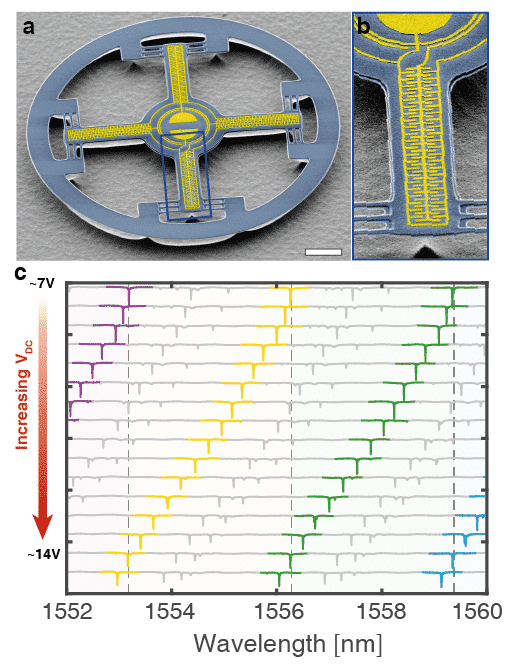
Free-Spectral-Range Electrical Tuning of a High-Quality Double-Disk Microcavity
2Centre for Microscopy and Microanalysis, The University of Queensland
We report free-spectral-range tuning in a high-quality on-chip microcavity requiring less than 15 V and 1 nW of power to maintain optical resonance with an arbitrary frequency: an important component for achieving reconfigurable photonic circuits.
Reconfigurable photonic circuits have many future applications. They are required, for instance, for the photonic interconnects in next generation computer architectures [1], for integrated quantum information networks [2] and coherent radar systems [3]. Free-spectral-range (FSR) tuneable high-quality microcavities are an essential element for providing reconfigurability to such circuits, allowing resonance to be achieved with any light source or between any number of networked optical devices, while also enabling the strong light-matter interactions required for components such as lasers, optical frequency combs, sensors, and quantum processors. However, FSR tuning becomes increasingly difficult as optical cavities are made smaller, competing with the demand for larger device densities in on-chip applications of photonic circuits to enable more complex networks and greater computational power.
In this presentation, we report the demonstration of electrical FSR tuning of a high-quality on-chip microcavity. To achieve this we utilise a double-disk geometry, consisting of two stacked disks separated by a thin air gap. The optical field of the cavity is shared between both disks, with a significant part of the energy situated in the gap. This provides a highly strain-dependent refractive index, as the optical resonance wavelength becomes very sensitive to changes in disk separation. Figure 1(a) shows an electron micrograph of the fabricated device, with sub-micrometer interdigitated gold electrodes integrated on top of each support spoke (Fig. 1(b)) to provide strong electrical actuation.
Using this structure, we demonstrate full FSR tuning of the cavity optical resonances with an applied voltage of less than 15 V (see Fig. 1(c)), with less than a nanowatt of power required to achieve and maintain resonance with an arbitrary frequency, and a full tuning range in excess of three FSRs for similar devices. We further demonstrate coupling to a passive cavity, mimicing coupling of arrays of dissimilar devices in a photonic network, optomechanical synchronization, tuning of a cavity to an atomic transition or coupling to a fixed-wavelength laser source.

[1] Atabaki et al. Nature 556 349 (2018); Kuramochi et al. Nature Photonics 8 474 (2014).
[2] Konoike et al. Science Advances 2 e1501690 (2016); Elshaari et al. Nature Communications 8 379 (2017); Aoki et al. Nature 443 671 (2006).
[3] Ghelfi et al. Nature 507 341 (2014); Xue et al. Journal of Lightwave Technology 36 2312 (2018).
email: c.bekker@uq.edu.au

Powered by Eventact EMS